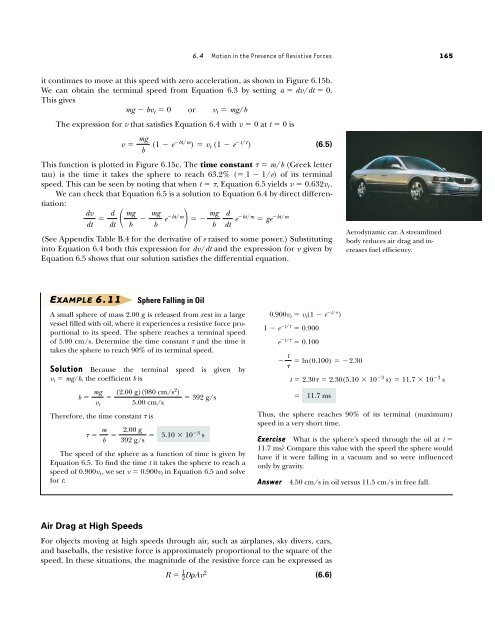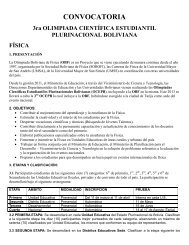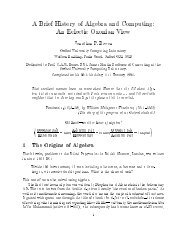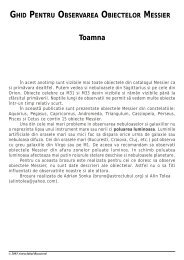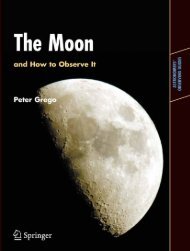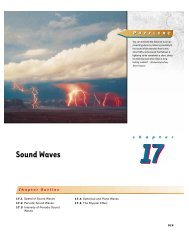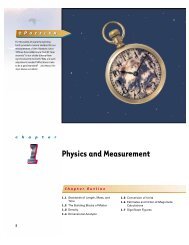Circular Motion and Other Applications of Newton's Laws
Circular Motion and Other Applications of Newton's Laws
Circular Motion and Other Applications of Newton's Laws
Create successful ePaper yourself
Turn your PDF publications into a flip-book with our unique Google optimized e-Paper software.
6.4 <strong>Motion</strong> in the Presence <strong>of</strong> Resistive Forces 165<br />
it continues to move at this speed with zero acceleration, as shown in Figure 6.15b.<br />
We can obtain the terminal speed from Equation 6.3 by setting a � dv/dt � 0.<br />
This gives<br />
mg � bvt � 0 or vt � mg/b<br />
The expression for v that satisfies Equation 6.4 with v � 0 at t � 0 is<br />
v � mg<br />
b (1 � e�bt/m ) � v t (1 � e �t/� )<br />
(6.5)<br />
This function is plotted in Figure 6.15c. The time constant � � m/b (Greek letter<br />
tau) is the time it takes the sphere to reach 63.2% <strong>of</strong> its terminal<br />
speed. This can be seen by noting that when t � �, Equation 6.5 yields v � 0.632vt. We can check that Equation 6.5 is a solution to Equation 6.4 by direct differentiation:<br />
dv d<br />
�<br />
dt dt � mg mg<br />
�<br />
b b e�bt/m� ��mg<br />
b d<br />
dt e�bt/m � ge�bt/m (� 1 � 1/e)<br />
(See Appendix Table B.4 for the derivative <strong>of</strong> e raised to some power.) Substituting<br />
into Equation 6.4 both this expression for dv/dt <strong>and</strong> the expression for v given by<br />
Equation 6.5 shows that our solution satisfies the differential equation.<br />
EXAMPLE 6.11<br />
Sphere Falling in Oil<br />
A small sphere <strong>of</strong> mass 2.00 g is released from rest in a large<br />
vessel filled with oil, where it experiences a resistive force proportional<br />
to its speed. The sphere reaches a terminal speed<br />
<strong>of</strong> 5.00 cm/s. Determine the time constant � <strong>and</strong> the time it<br />
takes the sphere to reach 90% <strong>of</strong> its terminal speed.<br />
Solution Because the terminal speed is given by<br />
vt � mg/b, the coefficient b is<br />
b � mg<br />
v t<br />
Therefore, the time constant � is<br />
� � m<br />
b<br />
� 2.00 g<br />
392 g/s �<br />
The speed <strong>of</strong> the sphere as a function <strong>of</strong> time is given by<br />
Equation 6.5. To find the time t it takes the sphere to reach a<br />
speed <strong>of</strong> 0.900v t, we set v � 0.900v t in Equation 6.5 <strong>and</strong> solve<br />
for t:<br />
Air Drag at High Speeds<br />
� (2.00 g)(980 cm/s2 )<br />
5.00 cm/s<br />
� 392 g/s<br />
5.10 � 10 �3 s<br />
0.900v t � v t(1 � e �t/� )<br />
1 � e �t/� � 0.900<br />
e �t/� � 0.100<br />
� t<br />
�<br />
� ln(0.100) ��2.30<br />
t � 2.30� � 2.30(5.10 � 10 �3 s) � 11.7 � 10 �3 s<br />
�<br />
11.7 ms<br />
For objects moving at high speeds through air, such as airplanes, sky divers, cars,<br />
<strong>and</strong> baseballs, the resistive force is approximately proportional to the square <strong>of</strong> the<br />
speed. In these situations, the magnitude <strong>of</strong> the resistive force can be expressed as<br />
R � 1<br />
2 D�Av2<br />
Thus, the sphere reaches 90% <strong>of</strong> its terminal (maximum)<br />
speed in a very short time.<br />
Exercise What is the sphere’s speed through the oil at t �<br />
11.7 ms? Compare this value with the speed the sphere would<br />
have if it were falling in a vacuum <strong>and</strong> so were influenced<br />
only by gravity.<br />
Answer 4.50 cm/s in oil versus 11.5 cm/s in free fall.<br />
(6.6)<br />
Aerodynamic car. A streamlined<br />
body reduces air drag <strong>and</strong> increases<br />
fuel efficiency.


